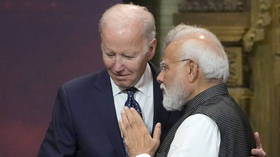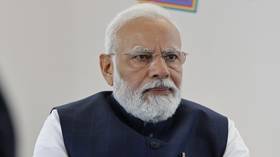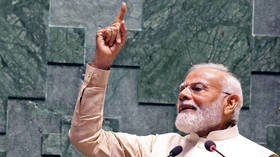What to expect from Modi’s first state visit to the US

Indian Prime Minister Narendra Modi’s first state visit to the US – the highest-ranked visit according to diplomatic protocol – is being described by senior American officials in near-hyperbolic terms.
The PM has visited the US six times since he took office in 2014, but the previous trips were categorized as various kinds of working visits or were related to participation in various multilateral events such as a Quad summit or the United Nations General Assembly. The designation “state visit” serves as an indication of the level of importance attached to this particular occasion.
Human rights aside
A “springboard” to touch new horizons, set “new benchmarks” in defense-industrial cooperation and propel the relationship into “escape velocity” are some of the descriptions that have been building up the hype around the visit. Modi’s jaunt to the US comes amid a willing suspension of disbelief by Washington regarding the Modi administration’s poor human rights record, despite having previously and periodically called it out on violations.
Modi’s three-day day visit comes amid accusations from human rights groups and opposition parties of muzzling dissent and pursuing divisive policies that discriminate against Muslims, India’s largest minority group, estimated to be over 15% of the country’s 1.4 billion population. The US is glossing over the “uncomfortable home truths” raised by Modi’s critics and maintains it is “playing a long game” with New Delhi.
A tight schedule
The Indian premier’s visit comes ahead of a key election year for both countries. Modi is only the third world leader after France’s Emmanuel Macron and South Korea’s Yoon Suk-yeol to be invited by President Biden for a state visit and dinner.
Modi, who represents India’s right-wing Bharatiya Janata Party (BJP), will start his US engagement in New York on June 21 with the celebration of the annual International Yoga Day. The date has been celebrated since 2015 after it was adopted in the New York-headquartered United Nations General Assembly (UNGA) on Modi’s initiative. “The PM will be paying respect to the bust of Mahatma Gandhi that now proudly adorns the North Lawn of the UN headquarters, where yoga will be conducted,” said Ruchira Komboj, India’s permanent representative to the UN.
This will be followed by an event focused on “skilling for the future” and intended to promote skills development and capacity building among the younger population. There, the visitor will be accompanied by the US first lady Dr. Jill Biden.
His first day in the US capital will end with a private dinner hosted by Biden and the First Lady.
On June 22, there will be a welcoming ceremony for Modi in the White House with over a thousand guests. The key members of the five-million-strong Indian diaspora – a critical voter base that is known to favor the Democrats – will grace the occasion. Modi will hold talks with Biden where they are expected to discuss strengthening engagement between the two nations in a bid to eliminate hurdles in building a resilient supply chain (read: reduce dependence on common rival China) and pave the way for a closer economic and technological ecosystem, which is the rubric of this state visit.
A rare feat for Modi
Later in the afternoon, at the invitation of Congressional leaders, including Speaker Kevin McCarthy and Senate majority leader Chuck Schumer, Modi will address a joint sitting of Congress, becoming the first Indian PM to do it twice. Few world leaders have addressed the US Congress more than once. The list includes British PM Winston Churchill and South African President Nelson Mandela.
In 2016, Modi addressed the US Congress during the Barack Obama administration, making him the sixth Indian PM to do so. Then, he said the two nations’ relationship had “overcome the hesitation of history,” and the current push for closer ties appears to uphold that statement.
The two co-chairs of the Congressional India Caucus, Congressmen Ro Khanna (a California Democrat) and Mike Waltz (a Florida Republican), played a pivotal role in persuading the Biden administration to extend an invitation to Modi while Congress was wading through the tricky debt-ceiling negotiations in May.
Possible Ukraine-related tension
However, Modi’s much-anticipated address to the joint sitting of Congress could become a source of some tension amid the bilateral bonhomie. Two key US Senators and long-time friends of India have slammed the BJP-led government over its stand on Russia after Moscow launched its special military operation against neighboring Ukraine in February 2022.
Senator Mark Warner, a Democrat and co-chair of the Senate India Caucus, has said that since “India has arrived as a truly great and one of the most important nations in the world, they can no longer take a pass” on major issues such as Russia’s “war on Ukraine.” Senator John Cornyn, the Republican co-chair, has said “it was a little bit disappointing that when Russia invaded Ukraine, India took a pass.” The Senators took a dig at the Modi administration while speaking at the Ideas Summit organized by the US-India Business Council, which was held in Washington on June 12 and 13.
Meetings with CEOs
With the address to Congress out of the way, in the evening President Biden and the First Lady will host a state dinner which hundreds of guests are expected to attend, including members of the Congress and celebrities.
On June 23, the last day of Modi’s visit to the US, Vice President Kamala Harris and Secretary of State Antony Blinken, fresh from his China trip, will jointly host a luncheon in honor of the Indian premier. Modi is scheduled to have interactions with CEOs, professionals and other stakeholders afterwards.
Though the Indian Ministry of External Affairs (MEA) has kept the names of the CEOs expected to call on Modi a “state secret,” Indian media report, citing unnamed sources, that some 20 leaders of top American companies are on the list. These include the CEOs of Visa, Mastercard, Adobe Systems, Coca-Cola, as well as SpaceX and Tesla CEO and Twitter owner Elon Musk.
In the evening, at the Ronald Reagan Center, Modi will address the Indian diaspora.
‘Robust leadership connect’
India’s foreign secretary Vinay Mohan Kwatra told the media during a special briefing in New Delhi on Monday that “the PM’s upcoming visit is rich both in form and substance that stems from a robust leadership connect, discussion on bilateral relationships, [a] transformative agenda in the years ahead and [serves to] develop new domains of partnerships that can be properly positioned. The State visit enjoys strong bipartisan support in the US Congress and comes on the back of three high-profile visits of US officials this year.” Kwatra was referring to the visits by Blinken, US Defense Secretary Lloyd Austin and National Security Advisor (NSA) Jake Sullivan. However, he refused to get into specifics while outlining Modi’s itinerary.
Massive trade ties
The foreign secretary dwelt on strong trade and investment partnerships between the US and India, which are touching $200 billion, and on technology interfaces in the telecom, space and manufacturing sectors. He made a reference to the US-India initiative on Critical and Emerging Technology (iCET), announced by Modi and Biden last May. The interlinked framework for cooperation on critical and emerging technologies will gather momentum during Modi’s US trip, according to MEA officials.
Transfer of defense technology
Deliverables and optics, including an agreement to co-produce General Electric (GE) jet engines in India, are likely to be the high point of the trip, according to sources. But the tipping point could be in transfer of technology (ToT), which is likely to be a work in progress and not handed over on a platter, as was earlier anticipated.
Meanwhile, the Biden administration has given its nod to the manufacture of F414 jet engines in India and begun the process of notifying Congress about the impending Memorandum of Understanding (MoU) to be signed between GE and India’s state-run Hindustan Aeronautics Limited (HAL). This is a significant aspect of Modi’s high-profit visit, as Washington has agreed to share sensitive defense capabilities with a non-ally with which it does not have a treaty. The jet engines will power Tejas MK 2 fighter planes, amid the US’ bid to wean India away from its traditional partner, Russia, and a steady decline in New Delhi’s dependence on Moscow for defense wares to 45% in 2017-2021 from an all-time high of 69% in 2012-2017.
With China, the elephant in the room looming large, India has been urging American companies to expedite creation of an ecosystem for semiconductor production, as Modi pushes for his ‘Made in India’ campaign to indigenize the defense sector.
Kwatra also cited India’s role as the rotating chair of the G20 presidency. New Delhi, according to the top diplomat, has emerged as the leading voice for countries in the Global South, where Modi has pitched for a full membership for the African Union (AU) in the elite grouping. The foreign secretary said India’s commitment to the presidency is evident in taking the bloc’s year-long events outside the national capital, New Delhi, and into as many as 140 destinations across the country.
Modi’s refusal to slam Russia
Ahead of his trip, Modi, in an exclusive interview to the Wall Street Journal, said, “There is an unprecedented trust between the leaders of the US and India.” He urged an overhaul of global institutions like the UN for broader representation, especially from countries in the Global South, in a multipolar world order. He reiterated his call for a fresh evaluation of the current list of members of the UN Security Council (UNSC). “The world should be asked if it wants India to be there,” he said, regarding New Delhi’s plea for full membership.
On Russia’s military operation in Ukraine, Modi gave a diplomatic response in line with India’s balancing act and in allusion to international law and the sovereignty of countries. “Disputes should be resolved with diplomacy and dialogue, not war… Some people say that we are neutral. But we are not neutral. We are on the side of peace… The world has full confidence that India’s topmost priority is peace,” he added.
The WSJ pressed Modi about US officials’ critical comments on him refusing to take a more forceful stance against Russia on Ukraine. “I don’t think this type of perception is widespread in the US,” the PM said. “I think India’s position is well known and well understood in the entire world. The world has full confidence that India’s topmost priority is peace,” he added.
A ‘landmark historic visit’
“We seek to deepen India-USA ties in key sectors like trade, commerce, innovation, technology and other such areas,” Modi tweeted on Tuesday before flying out to New York on what has been described as a “landmark historic visit.” Modi is the third Indian leader to make a State visit to the US and joins the ranks of former President Dr. Sarvapalli Radhakrishnan, who visited in June 1963, and former PM Dr. Manmohan Singh, who visited in November 2009. His next trip abroad is scheduled for June 24, when he will head to Egypt for the first time. The North African nation is a key Russian ally and is keen to join BRICS.















